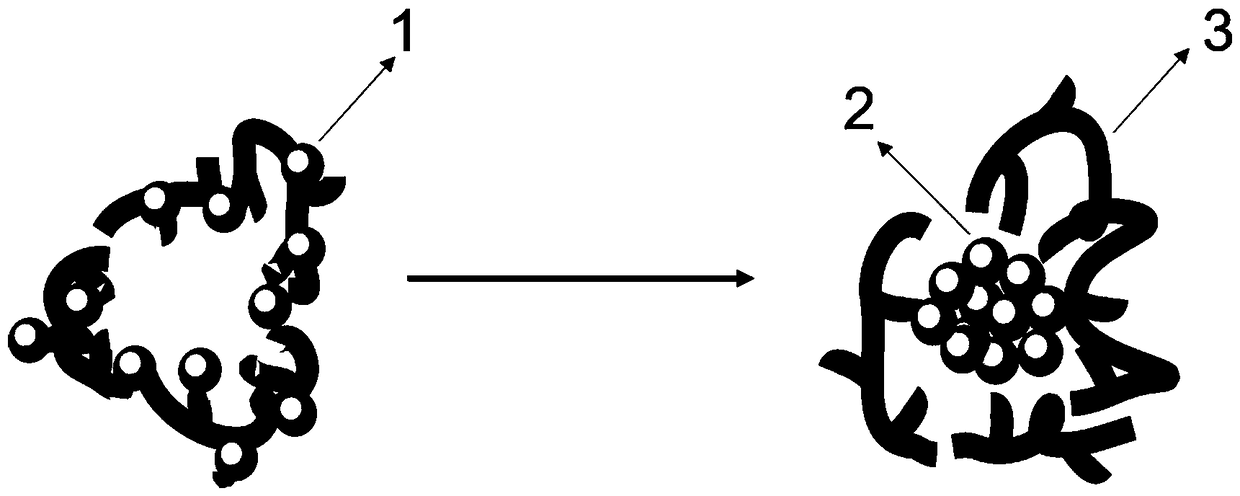Preparation method and application of fluorescent platinum nanoclusters for optical imaging of blood system suspension cells
A technology for suspended cells and blood systems, applied in the field of new materials, can solve the problems of difficult detection and difficult calibration of suspended cells, and achieve the effects of small size, easy operation, and high quantum fluorescence yield.
- Summary
- Abstract
- Description
- Claims
- Application Information
AI Technical Summary
Problems solved by technology
Method used
Image
Examples
Embodiment 1
[0017] Preparation method of fluorescent platinum nanoclusters: add H in 3.0 mL water 2 PtCl 6 and polyvinylimine PEI, final H 2 PtCl 6 and PEI concentrations were 0.1 mmol / L and 2 mmol / L, respectively. After fully mixing at 25 °C for 30 min, 0.1 mmol of L-ascorbic acid was added, the solution was heated to 90 °C, reacted for 2 h and cooled naturally to obtain a light yellow solution. The above crude product was ultracentrifuged and dialyzed with a dialysis bag for 1 day to obtain the final fluorescent platinum nanoclusters, which emitted light blue fluorescence under ultraviolet light irradiation.
[0018] Fluorescent imaging of suspended cells in the blood system: Take the fluorescent platinum nanoclusters obtained in the above step and add them to the sterile RPMI-1640 culture medium (containing 10% serum) containing K562 cells. The final concentration of fluorescent platinum nanoclusters is 0.001mmol / L. Purified air (5% CO) in a sterile environment at 37 °C 2 ) under...
Embodiment 2
[0020] Preparation method of fluorescent platinum nanoclusters: add H in 3.0 mL water 2 PtCl 6 and polyvinylimine PEI, final H 2 PtCl 6 and PEI concentrations were 0.6 mmol / L and 2 mmol / L, respectively. After mixing thoroughly at -4 °C for 24 h, 0.1 mmol of L-ascorbic acid was added, the solution was heated to 90 °C, reacted for 4 days, and cooled naturally to obtain a yellow solution. The above crude product was ultracentrifuged and dialyzed with a dialysis bag for 2 days to obtain the final fluorescent platinum nanoclusters, which emitted yellow fluorescence under ultraviolet light irradiation.
[0021] Fluorescent imaging of suspended cells in the blood system: Take the fluorescent platinum nanoclusters obtained in the above step and add them to the sterile RPMI-1640 culture medium (containing 10% serum) containing K562 cells. The final concentration of fluorescent platinum nanoclusters is 0.001mmol / L. Purified air (5% CO) in a sterile environment at 37 °C 2 ) under t...
Embodiment 3
[0023] Preparation method of fluorescent platinum nanoclusters: add H in 3.0 mL water 2 PtCl 6 and polyvinylimine PEI, final H 2 PtCl 6 and PEI concentrations were 0.6 mmol / L and 2 mmol / L, respectively. After mixing thoroughly at 60 °C for 1.5 h, 0.1 mmol of L-ascorbic acid was added, the solution was heated to 90 °C, reacted for 4 days, and cooled naturally to obtain a yellow solution. The above crude product was ultracentrifuged and dialyzed with a dialysis bag for 2 days to obtain the final fluorescent platinum nanoclusters, which emitted yellow fluorescence under ultraviolet light irradiation.
[0024] Fluorescent imaging of suspended cells in the blood system: Take the fluorescent platinum nanoclusters obtained in the above step and add them to the sterile RPMI-1640 culture medium (containing 10% serum) containing BV173 cells. The final concentration of fluorescent platinum nanoclusters is 0.005 mmol / L. Purified air (5% CO) in a sterile environment at 37 °C 2 ) unde...
PUM
 Login to View More
Login to View More Abstract
Description
Claims
Application Information
 Login to View More
Login to View More - R&D
- Intellectual Property
- Life Sciences
- Materials
- Tech Scout
- Unparalleled Data Quality
- Higher Quality Content
- 60% Fewer Hallucinations
Browse by: Latest US Patents, China's latest patents, Technical Efficacy Thesaurus, Application Domain, Technology Topic, Popular Technical Reports.
© 2025 PatSnap. All rights reserved.Legal|Privacy policy|Modern Slavery Act Transparency Statement|Sitemap|About US| Contact US: help@patsnap.com

